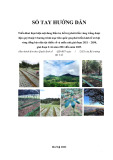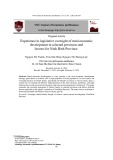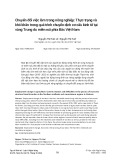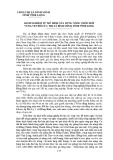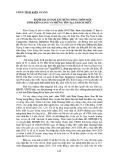
10 Journal of Development and Integration, No. 79 (2024)
No. 79 (2024) 10-22 I jdi.uef.edu.vn
K E Y W O R D S A B S T R A C T
Da Lat City,
Contingent Valuation
Method,
Landscape preservation,
Willingness to pay.
Da Lat City, Viet Nam, a renowned tourism destination, faces significant challenges in
preserving its landscape amid rapid population growth and tourism expansion. This study
aims to identify the determinants of residents’ willingness to pay (WTP) for landscape
conservation efforts. Utilizing primary data from 120 residents, the contingent valuation
method was employed for analysis. Findings reveal a robust public awareness and
concern for landscape preservation. While residents generally view the infrastructure
and tourism developments in Da Lat positively, there is a significant need to address
concerns regarding the preservation of natural and diverse landscapes. Many respondents
expressed worries about potential adverse outcomes, particularly the loss of Da Lat’s
unique air quality, which could impact identity, tourism appeal, climate, agriculture, and
biodiversity. The study found an inverse relationship between price levels and WTP,
with higher prices leading to lower acceptance rates and higher rejection rates. Key
factors influencing residents’ WTP include income, infrastructure development, and the
importance of tourism. Policy implications include supporting traditional agricultural
practices, integrating green infrastructure into urban planning, formulating regulations for
open space preservation, conserving urban heritage, and recognizing the social benefits of
agricultural landscapes. These insights are critical for developing effective strategies to
preserve Da Lat’s urban landscapes.
* Corresponding author. Email: hoanghaanh@hcmuaf.edu.vn
https://doi.org/10.61602/jdi.2024.79.02
Received: 19-Aug-24; Revised: 15-Sep-24; Accepted: 18-Sep-24; Online: 29-Oct-24
ISSN (print): 1859-428X, ISSN (online): 2815-6234
Hoang Ha Anh*, Tran Minh Da Hanh, Tran Nguyen Minh Tuyen
Nong Lam University, Vietnam
Determinants of residents’ willingness to pay for landscape
preservation: A case study in Central Da Lat City, Viet Nam
1. Introduction
Urban landscapes are crucial to enhancing the
quality of life and well-being of city residents
by providing aesthetic value and supporting
environmental sustainability. Da Lat City, located
in the Central Highlands of Vietnam, is renowned
for its picturesque scenery, diverse ecosystems,
and cool climate, making it a popular destination
for both tourists and residents. However, rapid
urbanization and tourism expansion pose
significant challenges to the preservation of the
city’s natural landscapes.
Over the past decade, urban expansion has
led to the conversion of agricultural lands and
green spaces into built-up areas, diminishing Da

11
Journal of Development and Integration, No. 79 (2024)
Lat’s natural charm. Notably, 55.61 km² of natural
habitats have been lost due to urbanization from
2010 to 2022 (Nguyen et al., 2023). Additionally,
the growth of tourism has altered iconic landmarks
such as Xuan Huong Lake and the Valley of Love,
potentially reducing their natural beauty and
authenticity.
Preserving these landscapes is critical not
only for maintaining the city’s environmental
sustainability but also for safeguarding its cultural
and historical heritage. With a diverse ecosystem
of forests, lakes, and flower gardens, Da Lat’s
landscape supports ecological balance and offers
vital ecosystem services such as water filtration
and climate regulation. Given these benefits,
conservation efforts in Da Lat are essential to
ensure the long-term well-being of residents and
the sustainable development of the city.
Although there is a limited amount of direct
research specifically examining the willingness to
pay (WTP) to preserve urban landscapes, several
studies in related contexts offer valuable insights.
Hu et al. (2014) reveal that socio-economic status
significantly impacts WTP for green infrastructure
in China, highlighting the critical influence of
income and other economic factors on financial
contributions to landscape preservation. This
finding is echoed by Chaudhry (2013), who
demonstrates that residents of Chandigarh,
India, are willing to make annual financial
contributions to improve and establish urban green
spaces, indicating a public commitment to urban
landscape enhancement. Similarly, a positive
correlation between income levels and WTP for
park preservation in southern Brazil was reported
(Brandli et al., 2015). This correlation is further
supported by Song et al. (2015), who identify a
comparable relationship between income and WTP
for urban green space conservation in Jinan, China.
These studies collectively suggest that higher-
income individuals are more inclined to financially
support urban landscape conservation. Expanding
on these insights, Idris et al. (2022) emphasize
the role of visitors’ perceptions and awareness
of green spaces in shaping their WTP in Padang,
Indonesia. This finding underscores the potential
of public education and awareness campaigns
to bolster financial support for urban landscape
preservation. Rodella et al. (2019); Rodella et
al. (2020) provide a comprehensive perspective
by integrating quantitative approaches, public
opinion, and economic estimation to assess WTP
for coastal scenery preservation in Italy. Their work
underscores the multifaceted value of landscapes
and the importance of considering both economic
and public opinion metrics in conservation
strategies. Contrasting with these trends, Tibesigwa
et al. (2020) present a nuanced view from Dar es
Salaam, Tanzania, where wealthier residents place
less importance on urban parks compared to their
poorer counterparts. This challenges the empirical
evidence from developed countries and highlights
the necessity for effective management, regular
maintenance, and institutional support to protect
urban green spaces from encroachment and misuse.
Zhang et al. (2023) focus on the Yangtze River
Middle Reaches Megalopolis in China, finding that
residents’ WTP to maintain and preserve ecosystem
services is driven more by environmental factors
than demographic factors, particularly proximity
to farmland, water, and forests. This emphasizes
the critical role of environmental context in
shaping public support for landscape preservation.
In a similar vein, Aziz et al. (2023) explore peri-
urban landscapes in Pakistan, revealing robust
community support for enhancing greenery, with
residents willing to contribute through volunteer
donations. This underscores the potential for
community-driven conservation initiatives in
urban settings. Zegeye et al. (2023) utilize the
contingent valuation method (CVM) to assess the
economic value of urban forest parks in Hawassa
City, Ethiopia. Their findings demonstrate that bid
cost and various socioeconomic and demographic
factors significantly affect WTP, providing a robust
framework for estimating the economic value of
urban green spaces.
While existing research has explored willingness
to pay for urban green space preservation in other
cities such as Padang (Idris et al., 2022), Dar es
Salaam (Tibesigwa et al., 2020), and even in the
broader context of Indonesia (Idris et al., 2022)
or Italy (Rodella et al., 2020), there is a dearth of
studies specifically focusing on similar landscapes
to Da Lat city. This gap hinders our understanding
of the unique factors and dynamics that influence
residents’ willingness to pay to preserve the urban
landscape in Da Lat. Therefore, further research
is needed to fill this gap and provide insights into
the preferences and perceptions of residents in Da
Hoang Ha Anh et al.

12 Journal of Development and Integration, No. 79 (2024)
Lat city regarding urban landscape preservation,
considering factors such as income, perception
of green spaces, and knowledge of functions.
Conducting such studies in Da Lat will not only
contribute to the existing literature on willingness
to pay for urban landscape preservation but also
provide valuable information for policymakers and
decision-makers in Da Lat city to develop effective
strategies and initiatives for urban landscape
preservation that align with the preferences and
needs of the local community.
In this manuscript, we first deliver an
introduction and a comprehensive literature
review that explores the concept of willingness
to pay (WTP) for urban landscape preservation.
This section draws upon empirical findings from
similar studies globally, establishing a theoretical
framework for our analysis. Subsequently, we
delineate the methodology adopted in our research,
detailing the survey approach and data collection
techniques utilized to gather data. Following this, we
present a detailed analysis of the empirical results,
scrutinizing the factors influencing individuals’
WTP for urban landscape preservation in Da Lat.
The manuscript culminates with a discussion
of the practical implications of our findings,
where we propose strategic recommendations for
policymakers and urban planners to enhance efforts
to preserve urban landscapes.
2. Methodology
2.1. Study area
Da Lat city is the provincial capital of Lam
Dong province, located on the Lam Vien plateau,
north of Lam Dong province, at an altitude of 1,500
meters above sea level, with an area of 394.64 km2,
situated on the Lam Vien plateau, belonging to the
Central Highlands region, Vietnam. To the north
of Da Lat city is Lac Duong district, to the east
and southeast is Don Duong district; while to the
west and southwest; the city borders Lam Ha and
Duc Trong districts. Da Lat City is approximately
300 km southwest of Ho Chi Minh City, with a
favourable location and transportation system for
expanding connections with economic centres in
the South and the Central Coast.
2.2. Methods
The Contingent Valuation Method (CVM)
was chosen for this study due to its effectiveness
Figure 1. Da Lat City map
Hoang Ha Anh et al.

13
Journal of Development and Integration, No. 79 (2024)
in estimating the economic value of non-market
goods, such as urban landscapes. This method has
been widely used in environmental economics
to assess individuals’ willingness to pay (WTP)
for public goods that do not have a direct market
price. Studies by Hu et al. (2014) and Rodella et
al. (2019), for example, have demonstrated the
applicability of CVM in similar contexts, where it
has been used to evaluate public preferences for
landscape preservation and green infrastructure.
Furthermore, Aziz et al. (2023) successfully applied
this method to assess urban landscape preservation
in rapidly developing areas, showing that CVM
provides robust and reliable estimates of WTP.
In addition, CVM’s flexibility allows for the
inclusion of detailed scenarios, which improves
respondents’ understanding of the preservation
projects being evaluated (Brandli et al., 2015;
Song et al., 2015). Given the unique landscape
and environmental importance of Da Lat, using
CVM enables a comprehensive understanding of
residents’ preferences for landscape preservation.
Moreover, CVM is particularly useful for
capturing both use and non-use values associated
with urban landscapes, which is critical for policy
decisions aimed at conservation efforts. Previous
research, such as Tibesigwa et al. (2020) and Zegeye
et al. (2023), has highlighted the importance of
these values in similar urban contexts.
CVM is favoured for several reasons. Firstly,
it directly elicits WTP by asking respondents how
much they would be willing to pay for specific
environmental improvements or preservation
efforts. This direct approach yields a clear measure
of the economic value individuals assign to urban
landscape preservation. Additionally, CVM allows
for considerable flexibility in survey design,
enabling the inclusion of detailed descriptions of
the preservation scenarios. This helps respondents
make informed decisions about their WTP, thereby
enhancing the reliability of the collected data.
Moreover, CVM is particularly well-suited for
estimating the value of urban landscapes, which
do not have market prices. It captures both use
and non-use values, providing a comprehensive
measure of the total economic value of landscape
preservation. Unlike methods relying on observed
market behavior, such as hedonic pricing or the
travel cost method, CVM can capture non-use
values like existence, bequest, and option values.
This capability is essential for urban landscape
preservation, where individuals may value the
existence of green spaces even if they do not use
them regularly.
The scenario-based approach of CVM uses
hypothetical situations to describe environmental
changes and their outcomes, allowing respondents
to consider their preferences in a controlled setting.
This method can simulate various preservation
scenarios and their potential impacts, providing
valuable insights for policymakers. Furthermore,
CVM’s wide applicability to a broad range of
environmental and public goods makes it a versatile
tool for economic valuation, especially in contexts
where market data is unavailable or inadequate.
The results from CVM studies offer direct
and actionable information for policymakers. By
understanding the public’s WTP for urban landscape
preservation, decision-makers can design effective
funding mechanisms and conservation strategies
that align with public preferences. Overall, CVM
provides a robust framework for estimating the
economic value of urban landscape preservation in
Da Lat city. Its ability to capture comprehensive
values, flexibility, and direct elicitation of WTP
make it an optimal choice for this study. The insights
will inform policymakers and urban planners in
developing sustainable strategies to preserve and
enhance Da Lat’s unique urban landscape.
In this study, a hypothetical scenario was
established to assess the WTP. Firstly, the
current situation in Da Lat city was described,
highlighting the increasing number of tourists and
the corresponding development and improvement
of infrastructure, including the presence of hotels,
guesthouses, and homestays. However, this
development also poses a potential threat to the
natural environment and landscape of Da Lat City,
as it can negatively impact air quality and the overall
natural scenery. To address this issue, the local
government proposed a project called Preservation
of the landscape of Da Lat. The project aimed to
allocate funds for various purposes, such as planting
more trees along the streets and constructing flower
beds to reduce vehicle emissions and enhance the
landscape. Additionally, a portion of the funds
would be used to protect the landscape in Da
Lat City from further development. Furthermore,
funds would also be allocated for research topics
related to landscape conservation in Da Lat City,
Hoang Ha Anh et al.

14 Journal of Development and Integration, No. 79 (2024)
analysing the significance of the landscape for air
quality, the environment, and the economy. Due to
financial constraints, the project faced a shortage of
investment capital, necessitating the contribution
of the local residents. This contribution would
involve individuals paying a one-time fee for the
project, and the specific amount and duration of
payment would be discussed with the community
leaders.
To determine an appropriate contribution amount
based on the willingness to pay of the residents, a
pilot survey was conducted with 10 respondents in
Da Lat city. The results showed that the minimum
WTP was 10,000 VND, while the maximum was
50,000 VND. Thus, a double-bound question
format was chosen to estimate the acceptance rate
of payment from the residents. The initial price
offered was set at 30,000 VND, and if the residents
accepted, a higher price would be proposed. If they
declined, a lower price would be suggested. The
specific price points used in the survey were 5,000
VND, 10,000 VND, 15,000 VND, 20,000 VND,
25,000 VND, and 30,000 VND. As a result, the
respondents’ answers would fall into one of four
combinations: (Yes, Yes), (Yes, No), (No, Yes), or
(No, No).
To analyse factors influencing people’s
probability of accepting WTP, a logit regression
model was employed as follows:
The explanatory variables are explained in
Table 1.
The proposed contribution amounts for the
assumed Preservation of the landscape of Da Lat
project include six levels: 5,000 VND, 10,000
VND, 15,000 VND, 20,000 VND, 25,000 VND,
and 30,000 VND. It is expected that as the proposed
contribution amount increases, the probability of
respondents being willing to pay will decrease.
Several factors can influence individuals’
willingness to contribute. Age is a proposed factor,
as older individuals tend to have more stable
financial situations and may be more willing to
contribute. Educational attainment is also important,
as individuals with higher levels of education
may have a better understanding of the benefits
of landscape conservation and therefore may be
more willing to pay for it. Income level is another
factor, with higher-income individuals generally
showing a greater willingness to contribute
(Iqbal & Hossain, 2023). The length of time an
individual has lived in Da Lat can also influence
their willingness to pay, with longer-term residents
often being more willing to contribute (Zegeye et
al., 2023). The level of infrastructure development
in the area can also impact individuals’ willingness
to contribute, with higher levels of development
potentially leading to a decrease in landscape
quality and, therefore, a greater willingness to
pay to preserve it. Moreover, the importance of
tourism in the area can also influence individuals’
willingness to contribute, as they may recognize
the benefits that landscape conservation can bring
to the tourism industry and, consequently, to the
Variables Explanations Units of measurement Expected signs References
P Price level Thousand VND/month (-)
GENDER Gender 0 = Female, 1 = Male
(Aziz et al., 2023; Iqbal
& Hossain, 2023; Zegeye
et al., 2023; Zhang et al.,
2023)
AGE Age Year (+)
EDU Education level Ordinal scale from 0 = Elementary to 6 = Postgraduate (+)
INC Income Million VND/month/household (+)
RES Length of residency Year (+)
DEV
Infrastructure
development
importance
5-points Likert scale (1 = Not developed at all in
terms of infrastructure, 5 = Very developed in terms of
infrastructure)
(+)
AWA Awareness about
urban landscape
5-points Likert scale (1 = Not important at all,
5 = Very important) (+) (Zegeye et al., 2023)
TOUR Importance of
tourism
5-points Likert scale (1 = Not important at all,
5 = Very important) (+) (Iqbal & Hossain, 2023)
Table 1. Variables summary
(1)
Hoang Ha Anh et al.


